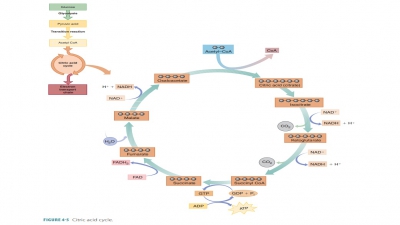Oxidation Reduction Reactions
| Home | | Anatomy and Physiology | | Anatomy and Physiology Health Education (APHE) |Chapter: Anatomy and Physiology for Health Professionals: Levels of Organization : Cellular Metabolism
Inside the cells, many reactions are described as oxidation reactions.
Oxidation Reduction
Reactions
Inside the cells, many reactions
are described as oxidation reactions. Oxidation is the
gain of oxygen or the loss of hydrogen. The oxidized substance always loses, or
nearly loses, electrons as they move either toward or to a substance with a
strong attraction for them. Nearly all oxidation of food fuels requires removal
or pairs of hydrogen atoms as well as pairs of electrons from substrate
molecules. This eventually leaves only carbon dioxide behind. The final
electron acceptor is molecular oxygen, which com-bines with the removed
hydrogen atoms at the end of the process, forming water.
When a substance loses electrons,
meaning it is oxidized, another substance gains electrons, mean-ing it is
reduced. Therefore, oxidation and reduc-tion are coupled reactions that are referred to as oxidation-reduction(redox) reactions. It is importantto understand
that oxidized substances lose energy, whereas reduced substances gain energy.
Oxidation of food fuels transfers their energy to many other molecules, and
then to adenosine diphosphate (ADP), which forms the energy rich ATP. Redox
reactions are catalyzed by enzymes, just like all other chemical reactions in
the body. Enzymes that catalyze redox reactions, in which hydrogen atoms are removed,
are known as dehydrogenases. Enzymes that catalyze the transfer of oxygen are oxidases.
Most dehydrogenases and oxidases
require assistance from a certain coenzyme, usually derived from a B vitamin.
These enzymes cannot accept hydrogen, meaning they cannot bond to it. How-ever,
their coenzymes can act as either
hydrogen or electron acceptors. They become reduced every time a substrate is
oxidized. For oxidative pathways, two important coenzymes are derived from two
specific B vitamins: nicotinamide adenine
dinucleo-tide (NAD+) derived from niacin andflavin adenine dinucleotide (FAD) derived from riboflavin.

